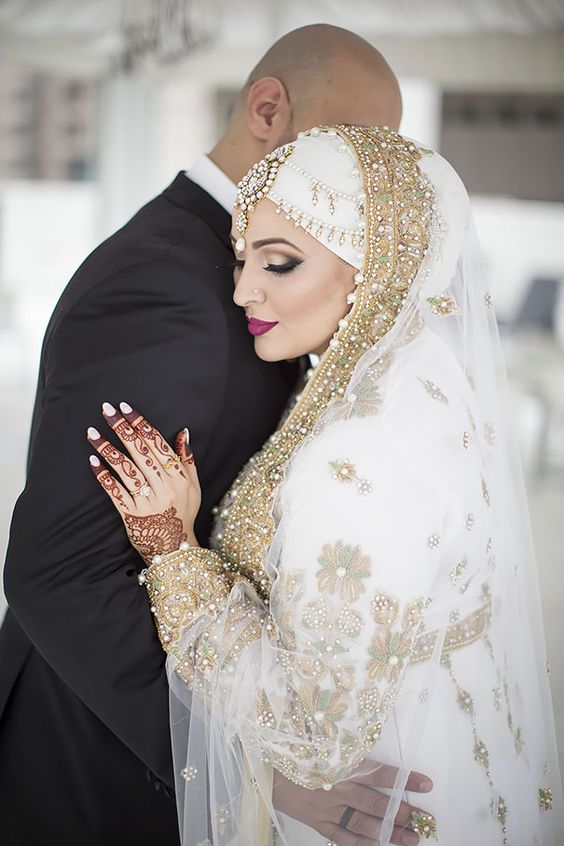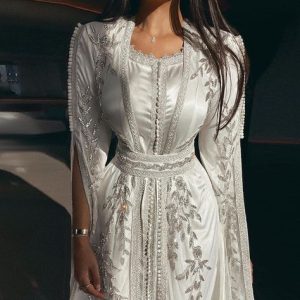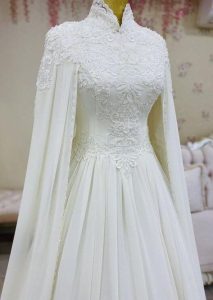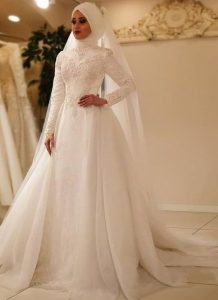Islamic weddings are beautiful celebrations of love and commitment. While traditions and customs vary across the vast Islamic world, there are some common elements that bind them together. One of these is the focus on modesty and elegance in wedding attire for both the bride and groom. This article explores traditional Islamic wedding dresses, providing a glimpse into the rich tapestry of Islamic cultures.
Principles of Islamic Dress
Islamic dress codes emphasize modesty for both men and women. Here’s a closer look at these principles:
Coverage:
Islamic teachings encourage covering the body from shoulders to knees.
Looseness:
Garments should be loose-fitting and not form-fitting.
Opacity:
Clothing should be opaque and not see-through.
Traditional Islamic Wedding Dress Styles
There’s a stunning variety of Islamic wedding dress styles worn around the world. Here are some popular examples:
-
Kaftan: The kaftan is a long, loose-fitting robe that is a popular choice in many Islamic cultures. It can be adorned with intricate embroidery, beadwork, or other embellishments.
-
Jalabiya: The jalabiya is another flowing garment that is popular in many Islamic countries. It can be made from various fabrics and can be quite simple or elaborately decorated.
-
Lehenga: The lehenga is a three-piece outfit consisting of a long skirt, a fitted bodice, and a dupatta (scarf). It is a popular choice in South Asian Islamic weddings and comes in a vibrant array of colors and fabrics.
-
Abaya: The abaya is a long, loose robe that covers the entire body. It is often worn with a headscarf and is a popular choice in some regions, particularly in the Arabian Peninsula.
Regional Variations
Within these styles, there are countless regional variations. Here are some examples:
- Morocco: Moroccan wedding dresses are often adorned with intricate beadwork and embroidery, reflecting the country’s rich heritage.
- Indonesia: Indonesian wedding dresses often feature batik fabrics and vibrant colors.
- Turkey: Turkish wedding dresses can be quite elaborate, with gold embroidery and flowing trains.
Modern Interpretations
Modern Islamic wedding dresses combine traditional elements with contemporary designs. Here are some trends:
- Modest silhouettes: Modern Islamic wedding dresses maintain a modest silhouette but can incorporate modern cuts and tailoring.
- High-quality fabrics: Luxurious fabrics like silk and satin are popular choices for modern Islamic wedding dresses.
- Elegant embellishments: Modern Islamic wedding dresses may feature intricate embroidery, beadwork, or other embellishments that add a touch of glamour.
The Importance of Personal Style
Islamic wedding attire is about more than just following tradition. It’s also about expressing personal style within the guidelines of modesty. Here are some things to consider:
- Cultural background: Many brides choose to incorporate elements from their cultural heritage into their wedding attire.
- Fabric and embellishments: The choice of fabric, embellishments, and overall style can reflect the bride’s personality.
- Comfort and fit: It’s important for the bride to feel comfortable and confident in her wedding dress.
Beyond the Dress: Completing the Look
The wedding dress is just one part of a beautiful Islamic wedding ensemble. Here are some other elements to consider:
- Hijab or headscarf: Many Muslim brides choose to wear a hijab or headscarf on their wedding day. There are many stylish and elegant hijab options available.
- Jewelry: Jewelry can be a way to add a personal touch to the wedding attire. However, Islamic teachings emphasize modesty, so jewelry should not be too ostentatious.
- Makeup: While makeup is a personal choice, it should be subtle and tasteful according to Islamic principles.
Islamic wedding dresses are beautiful and elegant expressions of faith and love. By understanding the principles of Islamic dress and exploring the rich variety of styles, brides can find a wedding dress that is both modest and reflects their personal style.
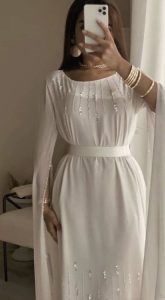
Colors and Fabrics
Traditional Islamic wedding dresses come in a wide range of colors and fabrics, depending on the region and culture. Here’s a look at some popular choices:
- Classic Colors: White, ivory, and cream are popular colors for Islamic wedding dresses, symbolizing purity and new beginnings.
- Vibrant Hues: In some cultures, brides opt for bright and vibrant colors like red, green, or blue. These colors can hold special meanings or represent joy and celebration.
- Luxurious Fabrics: Silk, satin, and chiffon are popular fabric choices for their luxurious feel and beautiful drape. More modest fabrics like cotton or linen are also commonly used.
Adding Elegance: Embellishments and Details
Many Islamic wedding dresses feature beautiful embellishments and details that add a touch of elegance and cultural flair. Here are some examples:
- Intricate Embroidery: Delicate embroidery with floral patterns, geometric designs, or calligraphy can adorn the dress.
- Sparkling Beadwork: Beadwork in various colors and patterns can add shimmer and texture to the dress.
- Gold or Silver Accents: Metallic threads or accents can add a touch of luxury and sophistication.
The Modern Bride: Balancing Tradition and Style
Modern Islamic wedding attire allows brides to express their personal style while staying true to the principles of modesty. Here are some ways this is achieved:
- Modern Cuts: Traditional silhouettes are given a modern twist with clean lines, fitted bodices, or flowing skirts.
- Veils and Head Coverings: Veils attached to the dress or separate head coverings can add a touch of mystery and elegance.
- Statement Jewelry: Subtle yet stylish jewelry can complement the overall look without compromising modesty.
Islamic wedding dresses are a beautiful blend of tradition, elegance, and personal expression. With a variety of styles, colors, and embellishments to choose from, brides can find a dress that reflects their faith and celebrates their special day.
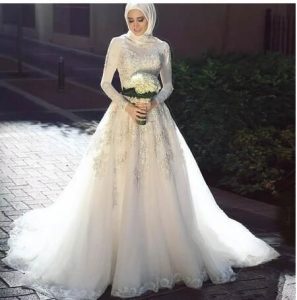
The Significance of the Wedding Dress
Islamic wedding dresses hold cultural and religious significance. Here’s a closer look:
- Symbol of Celebration: The wedding dress is a symbol of joy and celebration for the bride and her family.
- Expression of Faith: The modest design reflects the Islamic principles of modesty and احترام (ihtiram), which means respect.
- Cultural Heritage: Wedding dresses can incorporate elements from a bride’s cultural background, creating a unique and personal expression of heritage.
Shopping for a Traditional Islamic Wedding Dress
Finding the perfect Islamic wedding dress can be an exciting experience. Here are some tips:
- Research styles: Explore different regional styles and modern interpretations to find a dress you love.
- Consider comfort: Choose a dress that allows for comfortable movement throughout the wedding festivities.
- Work with a reputable bridal boutique: Consult with experienced consultants who can help you find a dress that flatters your figure and adheres to your modesty preferences.
